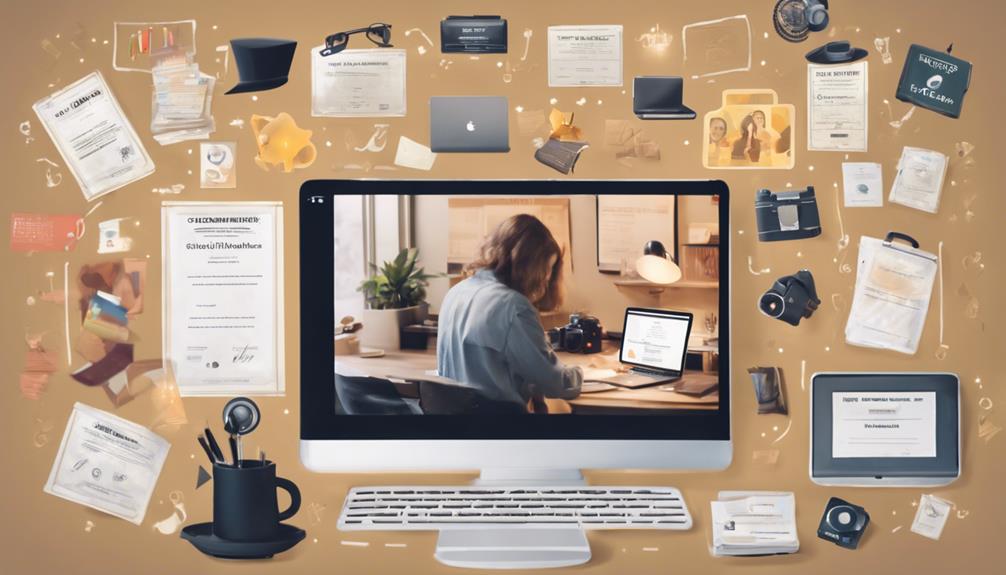Mastering essential leadership skills is key to standing out in any company. Effectively communicate, build strong relationships, solve problems strategically, make sound decisions, and delegate efficiently. These qualities showcase your leadership potential and set you apart from others. Showcasing these skills highlights your capability to lead teams effectively and drive success in any organization. So, continue exploring ways to hone these skills and enhance your leadership abilities to excel in your career.
Key Takeaways
- Master effective communication skills to convey vision and goals clearly.
- Demonstrate strong decision-making abilities under pressure.
- Showcase strategic problem-solving techniques to drive innovation.
- Highlight efficient delegation strategies for maximizing team productivity.
- Emphasize interpersonal relationship building for enhanced team collaboration.
Effective Communication Skills

To excel in leadership, you must hone your effective communication skills. This encompasses speaking, listening, writing, and visual communication. Communication skills are the cornerstone of strong leadership qualities. They're essential for fostering teamwork, building relationships, and achieving common goals within a team or organization.
Employers value effective communication immensely, with 45.2% considering it the most vital quality in a leader.
Mastering Interpersonal Relationships

To excel in leadership, focus on mastering interpersonal relationships by building strong bonds and fostering effective team collaboration. Strengthening these connections can enhance job satisfaction, boost productivity, and elevate team morale in the workplace.
Building Strong Bonds
Developing strong interpersonal relationships in the workplace is essential for fostering a positive and productive team environment. To build strong bonds with your team members, effective communication and active listening are crucial. By engaging in open and honest dialogues and truly listening to your colleagues, you can create a sense of trust and understanding within the team. This, in turn, can lead to improved team dynamics and collaboration.
| Building Strong Bonds | |
|---|---|
| Key Components | Benefits |
| Effective Communication | Increased employee engagement |
| Active Listening | Higher productivity |
| Trust and Respect | Better conflict resolution |
| Positive Work Environment | Enhanced job satisfaction |
| Improved Team Dynamics | Better overall performance |
Effective Team Collaboration
Mastering effective team collaboration hinges on cultivating strong interpersonal relationships within your team. Team collaboration is essential for achieving common goals, and fostering strong interpersonal relationships among team members leads to a more engaged and loyal team.
Building trust and rapport within the team enhances productivity and the quality of work produced. It's vital to master conflict resolution skills to maintain harmonious team dynamics when disagreements arise.
Encouraging teamwork not only fosters a positive work environment but also improves overall team performance. By prioritizing interpersonal relationships and effective communication, you can create a cohesive and successful team that works together towards shared objectives.
Strategic Problem-Solving Techniques

Enhance your leadership skills by mastering strategic problem-solving techniques. Problem-solving is an essential aspect of effective leadership, requiring the ability to analyze complex issues, identify root causes, and develop innovative solutions. By incorporating data-driven approaches into your problem-solving process, you can make more informed decisions that lead to successful outcomes. Strategic problem-solving techniques not only help in addressing current challenges but also pave the way for driving innovation within your team and company.
Employing strategic problem-solving skills can greatly improve efficiency, productivity, and overall performance. Leaders who excel in this area are better equipped to navigate obstacles, overcome challenges, and differentiate themselves as valuable assets in any organization.
Sound Decision-Making Abilities

You must hone your ability to make quick and effective decisions under pressure, as this skill is a hallmark of great leadership. Furthermore, being able to make quick and effective decisions under pressure is essential for navigating the challenges and uncertainties that often come with leadership roles. Strong leadership skills include the ability to think critically, assess risks, and take decisive action in high-pressure situations. Practicing and refining these skills will help you become a more effective and confident leader in any circumstance.
Your strategic choices play a critical role in determining the success of your team or organization, highlighting the importance of your decision-making prowess.
Your impactful decision-making skills can set you apart from your peers and drive superior performance.
Decisive Leadership Under Pressure
Strong decision-making abilities under pressure are crucial for effective leadership, greatly influencing team performance and overall success. Decisive leadership involves making sound decisions even in the face of challenging circumstances. Research shows that leaders who can make well-thought-out choices under pressure are 12 times more likely to excel in their roles.
This ability is critical, as 90% of executives believe that strong decision-making skills are essential for effective leadership. When leaders exhibit effective decision-making under pressure, team performance can increase by fourfold. Not only does this benefit the team, but it also fosters a more engaged workforce, with 65% of employees feeling more connected to their work when their leaders make clear and timely decisions.
Additionally, leaders who demonstrate decisive decision-making skills under pressure are perceived as more trustworthy and competent, further solidifying the importance of this trait in effective leadership.
Strategic Choices for Success
Making strategic choices for success requires leaders to consistently demonstrate sound decision-making abilities in various circumstances. Effective decision-making plays a critical role in problem-solving and enhancing team efficiency within an organization.
Research indicates that 70% of organizations identify strong decision-making as a top leadership skill, highlighting its importance in driving success. Employees themselves acknowledge this correlation, with 82% believing that the quality of leadership decisions directly impacts the company's overall performance.
When leaders make sound decisions under pressure, it not only showcases their competence but also instills confidence in their team members. Those who excel in decision-making are more likely to steer their organization towards success and achieve strategic goals effectively.
Impactful Decision-Making Skills
Developing essential decision-making skills involves mastering the art of gathering information, trusting your instincts, and guiding your team through pivotal choices. To make significant decisions, it's important to embrace calculated risks and demonstrate confidence in your choices.
Sound decision-making skills entail weighing all available information, listening to your intuition, and leading your team towards the best course of action. Effective leaders stand out by consistently making smart decisions that contribute to the success and growth of the organization.
They aren't afraid to make tough decisions, even when they're unpopular, as these choices are often necessary for progress and development. Leaders who excel in decision-making can inspire trust, build credibility, and drive positive outcomes within their teams and companies.
Efficient Delegation Strategies

When delegating tasks as a leader, it's important to implement efficient strategies that maximize team productivity and engagement. Effective delegation plays a pivotal role in increasing productivity within a team. According to a study by Harvard Business Review, it can boost productivity by up to 25%.
Not only does proper delegation enhance productivity, but it also leads to a 30% increase in team performance when tasks are assigned based on individual strengths.
Moreover, delegating tasks effectively can contribute to higher levels of employee engagement, with 70% of employees feeling more engaged when managers distribute tasks appropriately. This engagement is essential for maintaining team morale and reducing burnout and turnover rates.
Top Leadership Qualities for 2024

To excel as a leader in 2024, you must embody key qualities such as empathy, focus, integrity, mentorship, and presence.
Empathy is pivotal for understanding and connecting with team members on a deeper level, fostering a supportive and collaborative environment.
Focus is essential for prioritizing tasks, setting goals, and driving organizational success with clarity and determination.
Integrity plays a crucial role in leadership, emphasizing honesty, transparency, and ethical decision-making in all interactions.
Mentorship is valuable for guiding and developing team members, helping them reach their full potential and fostering a culture of continuous growth.
Presence is significant in 2024, highlighting the importance of actively engaging with the team, being visible, and influencing team performance positively.
Essential Leadership Skills for Future Leaders

Future leaders must prioritize honing essential leadership skills to succeed in any company. To stand out, focus on developing strong communication abilities and effective team-building strategies.
Effective communication is key to conveying your vision and goals clearly to your team, fostering trust, and ensuring everyone is on the same page. Being able to make decisions confidently and promptly is essential in leadership roles.
Future leaders should also embrace team building and collaboration, as these skills are essential for creating a positive and productive work environment. Additionally, agility, strategic thinking, and adaptability are crucial for maneuvering the ever-changing business landscape.
Differentiating Yourself From Other Candidates

Stand out from other candidates by highlighting your unique achievements and experiences to differentiate yourself effectively. When crafting your resume, focus on showcasing specific leadership skills that set you apart.
Highlight how your experiences align with the company's values and goals to demonstrate your potential contribution. Quantify your accomplishments by using metrics or numbers to showcase your impact in previous roles. Employers value tangible results, so make sure to show how your actions have positively influenced teams or projects.
Personalizing your cover letter is another pivotal step in standing out. Address the company's specific needs and explain how your background and skills can add value. This tailored approach demonstrates your genuine interest and understanding of the organization.
Furthermore, take advantage of networking opportunities to create meaningful connections. Building relationships within the industry can help you distinguish yourself from other candidates and potentially open doors to new opportunities.
Networking allows you to showcase your personality and qualities that may not be apparent on paper, giving you a competitive edge in the job market.
Frequently Asked Questions
What Qualities Make You Stand Out as a Leader?
You stand out as a leader when you excel in communication, have strong interpersonal skills, demonstrate problem-solving abilities, make smart decisions under pressure, and effectively delegate tasks. These qualities are valued by employers.
What Are the Top 3 Leadership Skills?
Assess situations wisely, make smart decisions, and delegate effectively to stand out. Employers value communication, problem-solving, and decision-making skills. Showcasing these on your resume sets you apart and enhances your leadership effectiveness.
What Are the 7 Leadership Qualities of Great Leaders?
You know that great leaders possess qualities like empathy, focus, integrity, mentorship, and presence. These traits are essential for connecting with your team, guiding them to success, and earning trust in any company.
What Are the 5 Qualities of a Good Leader?
Focus on communication, empathy, integrity, mentorship, and presence. These qualities make a good leader. Stand out in any company by showcasing your leadership attributes with quantifiable achievements on your resume.
Conclusion
As you continue to hone your leadership skills, remember that standing out in any company requires more than just basic abilities.
By mastering communication, relationships, problem-solving, decision-making, and delegation, you can differentiate yourself from other candidates and become a top leader in 2024.
Keep pushing yourself to grow and develop these essential qualities, and watch as your career trajectory takes off like a rocket soaring through the sky.









